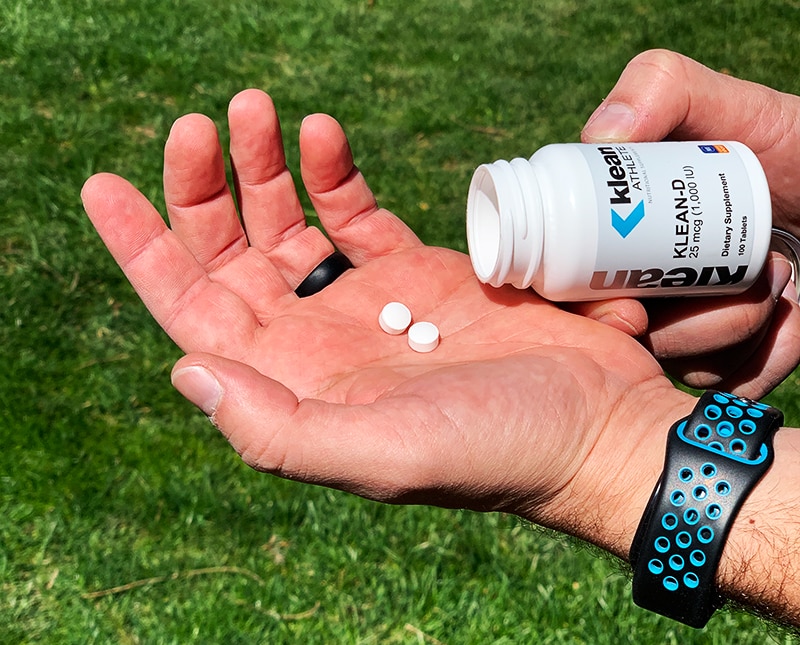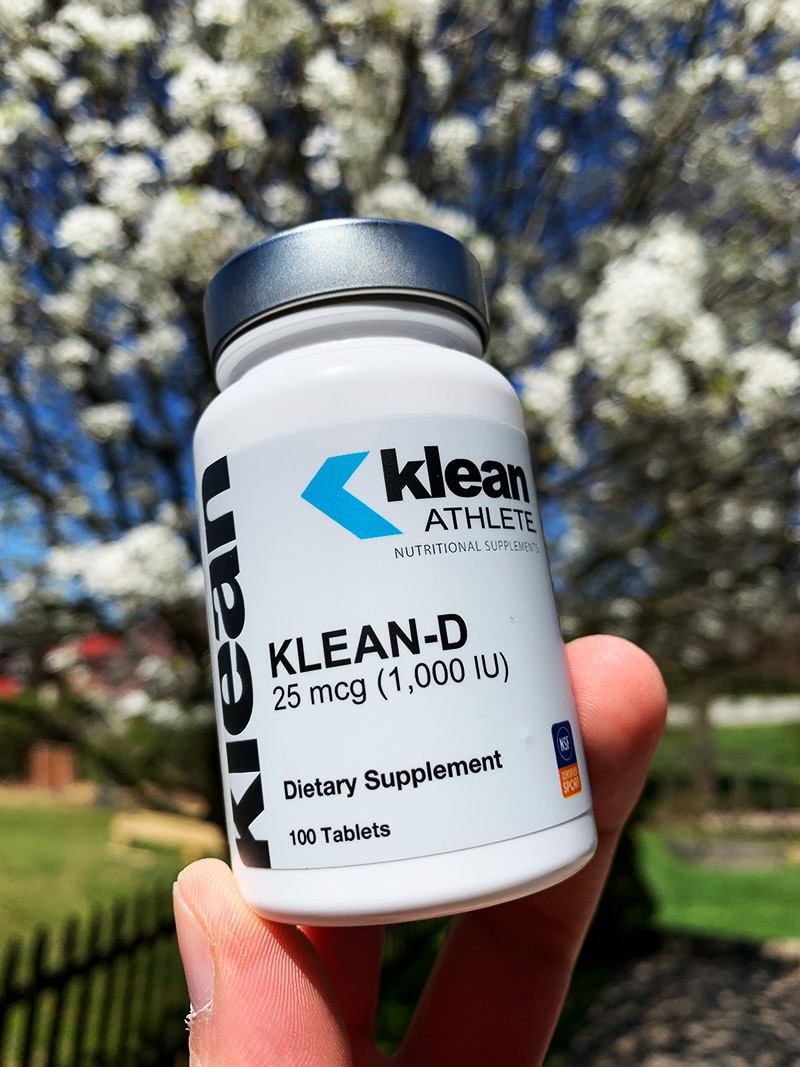Why Athletes and Active People May Benefit from Vitamin D Supplementation
Created by sponsored advisor and friend Angie Asche, MS, RD, CSSD
(biography click here)
Research on the relationship between vitamin D and athletes continues to develop, and while a large number of studies have pointed to vitamin D’s role in bone health, studies have also examined its impact on performance and immune function. Athletes with suboptimal vitamin D levels may not perform at their best.‡
It is estimated that over 1 billion people worldwide have vitamin D insufficiency. The Third National Health and Nutrition Examination Survey (NHANES III) demonstrated a significant increase in vitamin D deficiency throughout the last 30 years in the U.S. alone, with over 77% of Americans considered to be vitamin D-insufficient.1 Causes include limited sun exposure, lack of fortified nutrition, skin pigmentation and malabsorption.
Vitamin D Insufficiency and Athletes
When comparing vitamin D status among athletes, researchers are finding similar numbers to those of the general population, although results depend largely on the type of sport (indoor vs. outdoor) and geographical location. Those in colder climates with less sun exposure are at greater risk. This means athletes who train indoors or have limited sun exposure during the winter months and do not supplement have to rely on their bodies’ vitamin D stores, putting them at risk for deficiency.
A study on basketball players attending the NBA combine found 32% of athletes to be deficient and 47% to be insufficient in vitamin D.2 Athletes with darker skin and who had suffered a previous injury (muscle strain, bone fractures) were found to have significantly lower vitamin D levels. In a study on football players attending the NFL combine, inadequate vitamin D was present in 59% of participants.3 Again, those at highest risk were athletes with darker skin and/or a positive injury history.
Studies have observed vitamin D levels in college athletes as well. A study on male and female NCAA D1 athletes from a variety of sports found 33.6% to have suboptimal vitamin D levels.4
Additional Benefits to Athletes
Not only is vitamin D important for bone health and preventing stress fractures, but it also influences muscle function. A study on elite ballet dancers found that dancers who supplemented with 2000 IU/day vitamin D had improvements in vertical jump (7% higher) and an increase in isometric strength (18%). The dancers who were receiving supplementation maintained better physical health than the control group.5‡
Along with potential performance benefits, vitamin D also plays a role in supporting a healthy immune system. Athletes with heavy training volumes have higher demands on their immune systems than recreationally active individuals. This makes elite athletes more likely to miss playing or competition. In athletes with optimal vitamin D levels, severity scores and days missing play or competition are significantly lower than those with vitamin D deficiency.‡
How to Test and Maintain Optimal Levels
Vitamin D status should be assessed as part of a nutritional assessment, and blood testing for 25(OH) D can be assessed by the athlete’s healthcare provider. While reference ranges do vary slightly, the Endocrine Society defines vitamin D deficiency as <20 ng/mL, insufficiency as 21-29 ng/mL, and sufficient as >30 ng/mL. Testing vitamin D levels and supplementing athletes who have below optimal status is an efficient and inexpensive way to promote bone health.‡
Although the recommended dietary allowance (RDA) for young adults is 800 IU or 20mcg/day, many healthcare professionals believe this to be too low, including the Endocrine Society. Their recommendations are to consume 1000 IU/day, and adults aged 19-50 to consume at least 1500-2000 IU/day in addition to sensible sun exposure to maintain optimal levels.6
While case reports of vitamin D toxicity are limited, there still remains risk of toxicity when supplementing with vitamin D. This can occur when doses reach >50,000 IU/day, with blood levels above 150 ng/mL. Sunlight alone cannot cause toxicity, as excess vitamin D is broken down by sunlight.
There are some whole food sources that contain vitamin D naturally; however, studies indicate athletes do not come close to meeting the dietary recommendations. One study found that only 5% of college athletes meet the U.S. RDA of 800 IU or 20mcg/day from food alone.7 Cod liver oil, salmon, and egg yolks are some whole food sources of vitamin D, with one egg yolk containing about 44 IU. Vitamin D is also fortified, or added to, beverages like milk, non-dairy milk alternatives, and some fruit juices and cereals. Athletes who do not achieve regular sun exposure need supplemental vitamin D or a combination of dietary intake and vitamin D supplementation to maintain optimal levels.‡
I recommend vitamin D levels be checked on an annual basis in athletes. If deficient or insufficient, athletes should be supplementing with vitamin D to help potentially improve performance and immune function.8 Consider 1000-4000 IU/day from a reputable company such as Klean Athlete.‡
Bio
Angie Asche, MS, RD, CSSD, is a sports dietitian, certified exercise physiologist, and the owner of Eleat Sports Nutrition®. Since founding her private practice, she has worked with hundreds of collegiate and professional athletes in the MLB, NHL, and NFL. Her company has become widely known across the social media space as providing evidence-based nutrition information. Her expertise and recipes have been featured in numerous publications, including Men’s Fitness, Muscle & Fitness, Food Network, Shape, Runner’s World, and NBC News.
References
- Ogan, D., & Pritchett, K. (2013, May 28). Vitamin D and the athlete: risks, recommendations, and benefits. Retrieved from https://www.ncbi.nlm.nih.gov/pmc/articles/PMC3725481/
- Fishman, M. P., Lombardo, S. J., & Kharrazi, F. D. (2016, July 6). Vitamin D Deficiency Among Professional Basketball Players. Retrieved from https://www.ncbi.nlm.nih.gov/pmc/articles/PMC4954546/?report=reader
- Rebolledo, B. J., Bernard, J. A., Werner, B. C., Finlay, A. K., Nwachukwu, B. U., Dare, D. M., … Rodeo, S. A. (2018, April). The Association of Vitamin D Status in Lower Extremity Muscle Strains and Core Muscle Injuries at the National Football League Combine. Retrieved from https://www.ncbi.nlm.nih.gov/pubmed/29275983
- Villacis, D., Yi, A., Jahn, R., Kephart, C. J., Charlton, T., Gamradt, S. C., … Hatch, G. F. R. (2014, July). Prevalence of Abnormal Vitamin D Levels Among Division I NCAA Athletes. Retrieved from https://www.ncbi.nlm.nih.gov/pubmed/24982708
- Wyon, M. A., Koutedakis, Y., Wolman, R., Nevill, A. M., & Allen, N. (2014, January). The influence of winter vitamin D supplementation on muscle function and injury occurrence in elite ballet dancers: a controlled study. Retrieved from https://www.ncbi.nlm.nih.gov/pubmed/23619160
- Holick, M. F., Binkley, N. C., Bischoff-Ferrari, H. A., Gordon, C. M., Hanley, D. A., Heaney, R. P., … Endocrine Society. (2011, July). Evaluation, treatment, and prevention of vitamin D deficiency: an Endocrine Society clinical practice guideline. Retrieved from https://www.ncbi.nlm.nih.gov/pubmed/21646368/
- Halliday, T. M., Peterson, N. J., Thomas, J. J., Kleppinger, K., Hollis, B. W., & Larson-Meyer, D. E. (2011, February). Vitamin D status relative to diet, lifestyle, injury, and illness in college athletes. Retrieved from https://www.ncbi.nlm.nih.gov/pubmed/20543748
- The Effect of Abnormal Vitamin D Levels in Athletes. (2018, July 5). Retrieved from https://doi.org/10.7812/TPP/17-216
Topics



